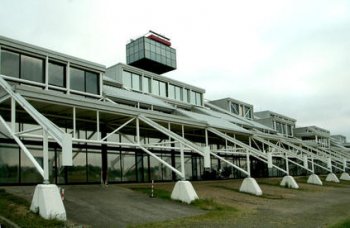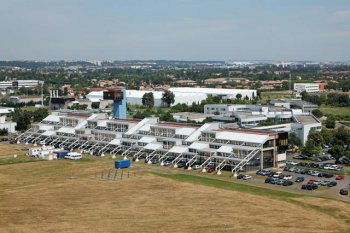The lab
Huge progress has been made during the last decades on atmospheric sciences and its cognate sciences on ocean and land surfaces.
There is no doubt that this trend will carry on in years to come as weather prediction and climate changes are of the out most importance to societies.
Research undertaken at Météo France plays a major role within the whole of French research, the European and the international communities. Relevant and better suited weather forecasts for end users together with a more realistic numerical prediction minimizing uncertainties about climate changes are the two main meteorological and climatic goals of today that are tackled by international research programmes.
Work at Météo France, under the patronage of CNRM, decidedly fits within the international scientific community.
Acknowledged as one of the leading international lab in matter of meteorological research, CNRM is not only the main Météo France lab in R&D but synchronizes all Météo France R&D. In partnership with CNRS CNRM’s main missions are:
– to have a better understanding not only of the atmosphere and its interfaces (soil, vegetation, snow cover, ocean) and the processes governing their interactions.
– but also of atmospheric models: weather forecasting in general but also of severe events, climate changes, seasonal forecasting, peaks of pollution, avalanche occurences, floods …
Per force, as many objectives of CNRM are steered by Météo France operational missions, this leads to a close collaboration with the production department and thus to prioritize research projects.
The top priority being the safety of people and properties: multi space and time scale weather forecast, physics and dynamics of the atmosphere, knowledge and evolution of the climate, links between man, climate and the atmosphere …
The different teams carry out the missions of CNRM and perform tests so very essential for up to date cognition.
To help them in their work, searchers enjoy the benefit of the latest available technology, super computer; satellites, instrumented aircrafts, permanent or mobile measuring stations, instrumented mountain sites, wind profiler radars, anchored and drifting buoys... and work in collaboration with several labs, universities, French and international institutes.
CNRS is thus involved with the work of the Intergovernmental Panel on Climate Change (IPCC, Peace Noble Prize 2007), WMO programmes, with research-related EU Framework Programme (Horizon H2020), with CNRS/INSU thematic programmes, with The French National Research Agency (Agence Nationale de la Recherche), and with Fondation STAE (Réseau Thématique de Recherche Avancée - Sciences et Technologies pour l’Aéronautique et l’Espace ).
The research at Météo France is involved with many socially and economically related projects, whether they are about the snow cover, avalanches, the West African monsoon, urban meteorology, droughts or Indian Ocean cyclonic events.
The strong motivation of the research units of CNRM thrives on these challenges, especially for better weather forecasting, to anticipate the consequences of severe meteorological events, to increase public awareness to climate changes.
Location & themes
CNRM is composed of six research teams together with a common personnel department spread out all over France (the Toulouse campus makes around 80% of this task force).
– The Numerical Weather Prediction and Assimilation Department (GMAP, Toulouse) is in charge of R&D, to implement new numerical weather prediction (NWP) software which take into account dynamics, physics parametrization and data assimilation.
– The Mesoscale Meteorology division (GMME, Toulouse) leads basic research (experimentally and numerically) on mesoscale and microscale processes of the atmosphere and its interfaces. Scientists work on research topics in cloud physics and storms, convective boundary layer, soil-vegetation-atmosphere transfers, remote-sensing of continental surfaces, mesoscale predictability, high-impact weather events and climate change impacts. In all of these areas, research seeks to improve the representation of the mesoscale processes within the Météo-France numerical weather prediction and climate models through development and improvement of physical parametrizations, mesoscale data assimilation, ensemble forecasting methods, downscaled or impact modelling.
– The Climate and Large scale Meteorology Department (GMGEC, Toulouse) studies climate projection (both globally & regionally) as well as seasonal forecast. The department also investigates sea-air fluxes interactions, the ozone evolution, troposphere-stratosphere, air quality, dynamics – atmospheric chemistry coupling. The department is also in charge of the “atmospheric” component of the French communal climate model and to make available to interested labs.
– The Experimental & Instrumental Meteorology Division (GMEI, Toulouse). The purpose of instrumental and experimental research is to develop new systems, such as a mesoscale network of automated meteorological stations, means for upper level sounding, a ST bi-frequency radar for vertical profile sensing, and a hydraulic ramp. The department is involved in the management and implementation of field campaigns for the scientific community at large.
– CAM (CAM,Toulouse-Francazal) is a department from CNRM in charge of SAFIRE, the backbone of a mixed unit between Météo France, CNRS-INSU and CNES, that looks after three instrumented aeroplanes (Falcon 20, ATR 42 & Piper Aztec) equipped and dedicated to environmental research and used during field campaigns by the French and European scientific community within frameworks such as EUFAR.
– The Snow Study Centre (CEN, Grenoble). The CEN aims to study the snow pack characteristics and its evolution, snow-atmosphere interactions, alpine meteorology, to develop tools for avalanche prediction (CEN coordinates for Météo France avalanches warning forecasts).





